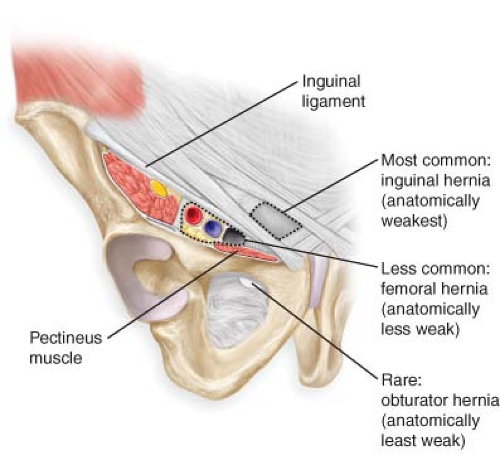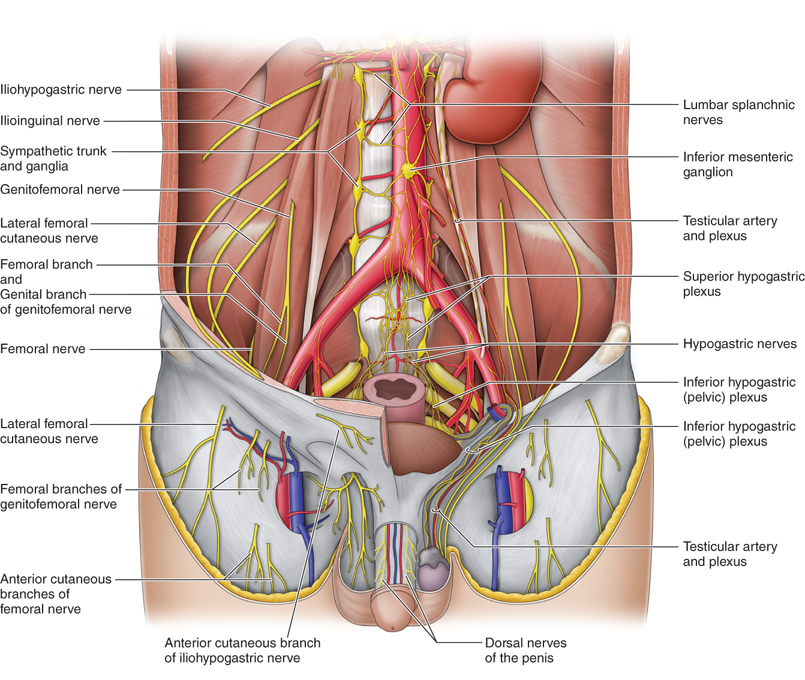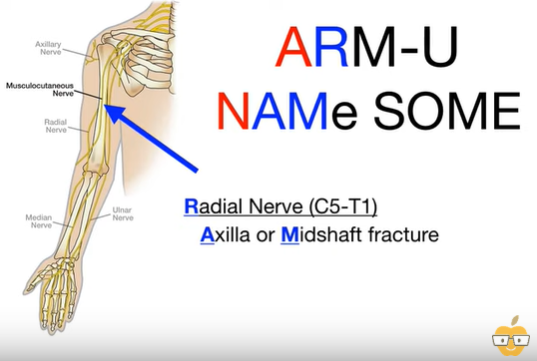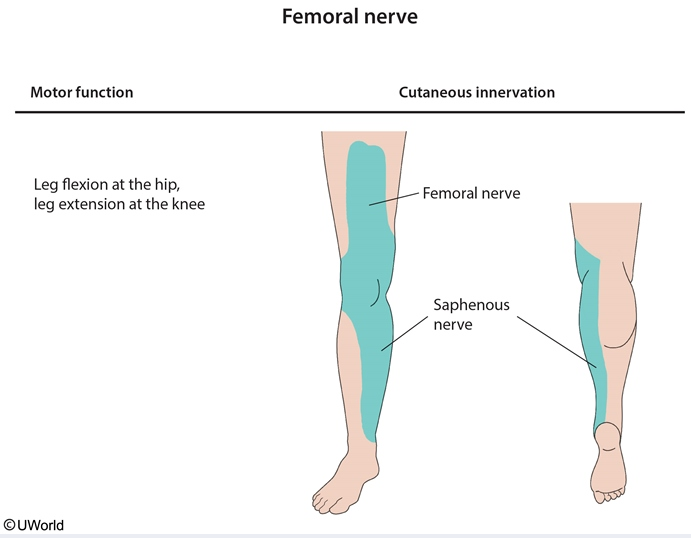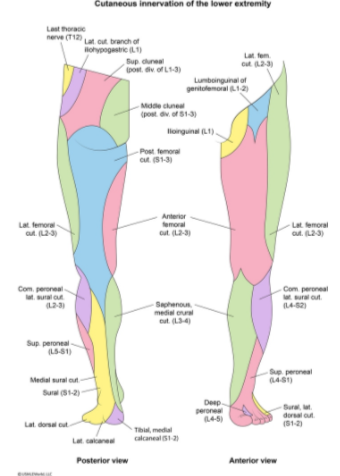Neurology - Spinal Nerves Map
*Home
Cervical Plexus
- C1 -C8
Thoracic Plexus
- T1 - T12
*Cervical Plexus
- C1 -C8
*Thoracic Plexus
- T1 - T12
*Notes - Spinal Nerves
- all Cervical spinal nerves exit above the vertebrae
- C8 is the dividing spinal nerve
- there are ONLY 7 C vertebrae
--> C8 is below vertebra 7 - all spinal nerves starting at T1 and below exit below the vertebrae
-
*LumboSacral Plexus
- contain both the sacral and lumbar plexeses
Lumbosacral Radiculopathy = Nerve Compressions
- SCIATICA = nonspecific term for compression of the lumbosacral nerve roots
- usually below L2
--> L5 and S1 are most common\ - L5 = "foot drop and big toe drop"
--> deep peroneal = big toe + deep in the cracks sensation
--> superficial peroneal = dorsiflexion - S1 = achillies reflex
--> "1 2 BUCKLE my SHOE"
Sacral Plexus
- S1 - S5
*Sacral Plexus
- S1 - S5
Lumbar Plexus
- L1 - L5
*Lumbar Plexus
- L1 - L5
- L1 = Inguinal
--> NOT involved in sciatia - L2 = front thigh
- L3 = outer thigh
- L4 = knee
--> "on all 4s" = knee reflex - L5 = "foot drop and big toe drop"
--> deep peroneal = big toe + deep in the cracks sensation
--> superficial peroneal = dorsiflexion - S1 = achillies reflex
--> "1 2 BUCKLE my SHOE"
*Sciatica
- SCIATICA = nonspecific term for compression of the lumbosacral nerve roots
*Brachial Plexus
- C5 - T1
Brachial Plexus --> think of REAL truckers and their J BRAKES (= brachial plexus)
"REAL Truckers Drink COLD BEER" (at rest stops)
- roots, trunks, divisions, cords, branches
"REAL Truckers TIP HIGH and play the LOWERING CLAW GAME at rest stops"
- Upper trunk lesion = "waiter's tip / ERBs palsy"
--> behind back (arm extended / internally rotated / pronated) - Lower trunk lesion = CLAW hand
*Phrenic Nerve
- comes from C3,c4,c5
*straight leg raise test for spinal radiculopathy
- tries to pinch the nerve to recreate the pain
*Pudendal Nerve
- from S2,s3,s4
- pudendal nerve responsible for the "anal wink" reflex
--> "s3,s4 = Winks Galore"
Pudendal Nerve Injury after pregnancy
- from stretching of the pelvis can cause damage
*Reflexes of the Cervical Roots
- C1 - C8
Posterior Chord
*Radial nerve
MOTOR
- ALL extensors of ENTIRE posterior arm
- triceps
- all posterior forearm extensors
SENSATION
- back of the arm
- back of the hand for 1st 3 1/2 digits
--> behind the median front coverage
Radial nerve "wrist drop" vs "finger drop"
- Radial nerve "wrist drop" = radial groove fracture
--> higher up so wrist affected - Radial nerve "finger drop / Saturday night palsy/screwdriver palsy" = supinator canal nerve compression
--> lower down so only the fingers are affected
*Radial nerve sensation
SENSATION
- back of the arm
- back of the hand for 1st 3 1/2 digits
--> behind the median front coverage
*Axillary nerve
MOTOR
- deltoid muscle
SENSATION
- ?
Axillary nerve sensation
-
Axillary nerve Motor
-
Lateral Chord
Medial Chord
.
Lateral Pectoral Nerve
.
*Median Nerve
*Musculocutaneous Nerve
.
Medial Pectoral Nerve
.
click to edit
*Obtuator Nerve
- origin = L2, L3, L4
- Motor innervation = obtuator muscle
--> - Motor innervation = adductor muscles
--> after obtuator canal divides into anterior and posterior branches to supply the 3 adductor muscles
--> adductor brevis, longis, magnus - Anatomy Course = posteromedial to IlleoPsoas muscle in pelvis
--> exits the pelvis through - Dermatomes = just above the knee on inner thigh
*Obtuator Foreman and Canal
- OF is the big foreman in the anterior o the pubic tubercle
- Obtuator membrane covers most of it
--> has a tiny hole in the obtuator membrane where the obtuator nerve anterior and posterior branches exit the pelvis
*Abdominal Nerves
- suprapubic areas sensation = illeohypogastric nerve
*Pubic and Supra Pubic Innervation
- Pubic sensation = illeoinguinal
- Suprapubic sensation = illeohypogastric
--> note the HYPOGASTRIC GI area
--> named after the ILLEO HYPOGASTRIC nerve that supplies innervation there
*illeohypogastric Nerve
- Suprapubic sensation = illeohypogastric
--> note the HYPOGASTRIC GI area
--> named after the ILLEO HYPOGASTRIC nerve that supplies innervation there - suprapubic catheder
--> this is the nerve that would sense pain when putting a supr pub catheder in
*illeoinguinal Nerve
- Pubic sensation = illeoinguinal
illeohypogastric Nerve injury - after appendectomy
Clinical Cases
Clinical Case
Clinical Case
Notes:
- note that
*Pelvic autonomic nerves
- note the prostatic plexus and cavernous nerves to the penis for Point and Shoot erection go together
- so radical prostatecomy has a risk of erectile dysfunction since you may take the parasympathetic cavernous nerves to the CORPUS CAVERNOSUM
*DIRTY USMLE
UPPER EXTREMITY NERVES
*Femoral Nerve
- femoral nerve part of the lumbar plexus
- think it is in front and above the sciatic nerve branches = tibial and fibular
*Ulnar nerve
MOTOR
SENSATION
-
Ulnar nerve
MOTOR
-
*Lateral Cutaneous Femoral Nerve = LCFN
- comes from L2L3
- NO motor
- Sensory ONLY to the lateral thigh
*Sciatic Nerve
- from the sacral plexus
- gives off the 2 major nerve branches that reach the foot
--> tibial and peroneal = fibular nerves - Tibial nerve
--> posterior calf muscles = 2x gastrocnemius, pantaris, soleus
--> plantar flexion - common peroneal = fibular nerve
--> superficial peroneal = eversion + most sensation
--> deep peroneal nerve = dorsiflexion + INVERSION
*common peroneal = fibular nerve
- splits into Deep and superficial branches of peroneal nerve
- note the peroneal = fibular nerve wraps around the top head of the fibula
--> common compression site or tear from fractures of fibula - superficial fibular branch = gives sensation to the dorsum of the foot
- deep fibular branch = gives mottor innervation to anterior muscle of leg that cause dorsi flexion of the foot
--> get foot drop when injured
*Superficial peroneal nerve
MOTOR innervation:
- 3 major foot INVERSION muscles = fibularus BLT
--> anterior tibialis
--> fibularis longus
--> fibularis tertius
SENSATION innervation:
- MOST sensation to the dorsum of the foot
--> just NOT DEEP and around the big toe = Deep peroneal nerve
*Inversion / Eversion
Inversion:
- title the Pantar Plane IN
Eversion:
- title the Pantar Plane EVERT
*Deep peroneal nerve
- deep fibular branch = gives mottor innervation to anterior muscle of leg that cause dorsi flexion of the foot
--> get foot drop when injured
MOTOR innervation:
- 1 + 3
- 1 major dorsiflexor
--> anterior tibialis - 4 LBs extensors of digits
--> extensor digitorum longus
--> extensor digitorum brevis
--> extensor hallicus longus
--> extensor hallicus brevis
SENSATION innervation:
- ONLY sensation the small space between the hallicus and 2nd digit
*Foot drop in Common peroneal nerve injury
- from trauma to fibular neck or casts applied too tight
*tibial nerve
- goves off the cutaneous sural nerve branch
- divides into posterior tibial nerve
*tibial nerve
- tibial nerve injury
--> can't do the tippy toe PLANTAR FLEXION
MOTOR innervation:
- ALL major plantarflexion muscles in leg + foot INVERSION (along with deep peroneal nerve)
--> anterior tibialis
--> fibularis longus
--> fibularis tertius - also innervates the flexor hallicus longus
SENSATION innervation:
- ONLY plantar!!
--> rest is fibular = deep + superficial
*tibial nerve MOTOR innervation:
- ALL major plantarflexion muscles in leg + foot INVERSION (along with deep peroneal nerve)
--> anterior tibialis
--> fibularis longus
--> fibularis tertius - also innervates the flexor hallicus longus
SENSATION innervation:
- plantar region of the foot
*Tom dick and Nervous Harry:
- go around the medial maleolus
*tibial nerve SENSATION innervation:
- plantar region of the foot
- INVERSION - The tibialis posterior, innervated by the tibial nerve, receives its main segmental innervation from L5. This muscle provides the majority of ankle INVERSION.
- If ankle EVERSION is weak, the lesion involves more than the common peroneal nerve.




















